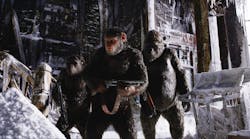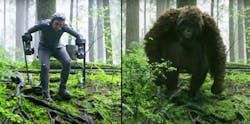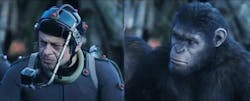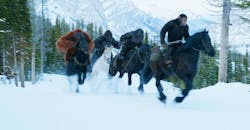Download the PDF of this article.
It’s nice to get a behind-the -scenes look at a movie, but even better when you can write about it. Well, I can finally do some of that for the upcoming “War for Planet of the Apes,” which arrives on July 14th—and we have a new trailer, too. It is the third in the series directed by Matt Reeves, starring Andy Serkis, Woody Harrelson, Steve Zahn, Amiah Miller, Karin Konoval, and Terry Notary. In this installment, Caesar (Serkis) is leading the apes against a human army led by the heartless Colonel (Harrelson).
I was one of a number of editors who got a look at the making of “War for the Planet of the Apes” on the movie’s Vancouver set last December. We had a chance to talk with the producer, director, and stars, along with the visual effects producer, Ryan Stafford. One thing that was clear from the discussion is that the story and presentation were paramount, and that the actors worked hard to deliver compelling scenes even while wearing prosthetics and motion-capture gear.
For the most part, the actors playing the human characters only had to contend with standard makeup, but those portraying the apes dealt with motion-capture makeup and gear. Prosthetics were used to help mimic the movements of apes, who have slightly different bodily structures than their human counterparts. A set of active emitters were also worn to allow gross motion capture of limb movements. The extra baggage can be challenging to work with, with but newer electronics that need less power definitely help.
Prosthetics allow actors to create more natural-looking movements, thus improving the realism of motion capture.
The active emitters worn by the actors use infrared LEDs to send encoded signals, which are captured by the cameras. Each emitter can then be identified, allowing software to properly map the desired virtual skin so the view of the actor is replaced by an ape in the final video. Subsequent video editing may still be required, but much less than in the past, as the matching of the recorded movements rendering process has been improved.
Another challenge facing the series has been the increasing number of apes within scenes—a figure which has more than tripled since the first film. That’s a lot of rendering, especially now that gorillas have been added to this mix.
There are more and more varied apes in “War for the Planet of the Apes.”
Luckily technology is helping to keep these special effects abreast of what the director wants. This is a combination of more processing power and streamlined software, as well as the more accurate detection of the sensors. Brighter LEDs makes a difference as well, since they allow for filming in daylight and bad weather.
Facial rendering, especially for close-ups, requires a bit more detail using head-mounted cameras. The actor’s face was painted daily with dots in fixed locations. A camera was then aimed at the face and recorded the movement of the dots, which were used in the same fashion as the active emitters worn on the body. The difference is that the camera is in a fixed position relative to the face so it is easy to track the dots, which is not the case with the active emitters. Those can be hidden by movements and reappear very distant from the point they were obscured.
The latest video capture gear has gotten smaller, lighter, and more power-efficient than that used in Dawn of the Planet of the Apes (shown here), but it essentially uses the same approach.
Camera resolution has gone up, camera size has been reduced, and battery life has been improved, making these cameras easier to bear. Nevertheless, the boom and camera still dictate how close actors can get to objects and other actors. In some instances, the face camera has to be removed and the special effects artist will need to do more manual editing. The results are transparent to the viewer.
This also highlights another change in the filming process: A scene that uses this type of special effect normally requires multiple recordings of the same scene with different attributes, and the recording hardware and software are designed to handle this. The typical process starts with a recording that includes all the participants. The next is done with some participants removed so the background can be recorded where the missing actor will be replaced by a rendered version. Another shot is often done with no actors in the scene.
The camera rig is mounted on a track and train, and camera positioning is recorded. The servos are used on the subsequent runs so the camera position and angle is the same each time through. The videos are combined in software.
The recording and editing are quite involved. Add this to the number of takes a particular scene may require and you can get a feel for the complexity of the process. It has significantly improved over time, and the results are quite impressive, but there is a lot of science, engineering, and art mixed into the equation—not to mention, what the director and actors are delivering. A 30-second clip may be the result of hours of work.
One of the first things we noticed when arriving at the site was how massive it was. This wasn’t surprising in and of itself for a big-budget picture like “War,” but the number and size of the green screens used was impressive. Imagine a football stadium with green screens from floor to roof hanging from cranes (so they could be moved).
One reason for such massive chroma key configurations was to allow more action to occur simultaneously that required special effects throughout. While it is possible to knit things together, the flow often suffers, and costs and turnaround time can significantly increase.
Producer Dylan Clark mentioned another reason for wider landscapes and bigger sets: A 65-mm format was used to deliver a very wide landscape. “Star Wars 9” is expected to be shot using the 65-mm format. Many notable films of the past have used this format, including “Ben Hur,” “Lawrence of Arabia,” and “2001: A Space Odyssey.” This change might have been due to an epic movie-watching splurge on the part of the producer, director, and others.
The green screens surrounded the large military complex that is central to the plot. Caesar has led his team from their encampment in Muir Woods to a snowy retreat. There is a bit of snow depicted, and that alone is a challenge for both actors and the VFX team (Fig. 4).
Blowing fur is one challenge for special effects artists and programmers. Adding in snow is quite another.
As alluded to earlier, humans have a different gait than the apes they play. The prosthetics helps correct some of that but what is less of an issue in most settings is where footsteps wind up. Those are not seen on a hard surface, and other techniques can be used to eliminate the need to replicate them in other settings. Unfortunately, that is not true for snow. This meant that scenes with apes walking in snow required the VFX artists to digitally recreate the entire path. And of course, there’s the issue of wet fur, which is more difficult to simulate.
The first two “Planet of the Apes” films did very well at the box office, and “War for the Planet of the Apes” looks on track to do even better. I’m looking forward to seeing the final incarnation.






